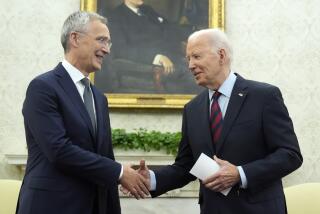Militants in Afghanistan launch attacks against NATO
KABUL, Afghanistan – NATO forces were struck by three attacks within 24 hours across Afghanistan, officials said Wednesday, as the Taliban redoubled efforts to drive foreign combat troops out of the country ahead of their planned withdrawal at the end of 2014.
In recent months, NATO forces have seen fewer fatalities as more of foreign troops withdraw, they take fewer risks and Afghan forces assume more responsibility for the country’s security. But analysts say militants continue to view attacks on international coalition troops as their most effective path to power.
In the most coordinated attack of the day, a suicide bomber in eastern Ghazni province detonated his vehicle Wednesday afternoon in the vicinity of a base shared by Polish and Afghan forces, coalition spokeswoman Lt. Col. LaTondra Kinley said. Information on the number of NATO casualties was not immediately available, she added.
The attack started when the driver detonated the minivan at the entrance, said Mohammad Ali Ahmadi, the deputy governor of Ghazni province. At that point, four or more Taliban gunmen started firing at the base with rocket-propelled grenade launchers and machine guns.
This sparked a firefight between the insurgents and Afghan forces guarding the perimeter of the base that lasted about 90 minutes, Ahmadi said. Because the base is near a residential area, four civilians were killed and 25 wounded, including women and children, he said, adding that a fuel tanker inside the base caught fire and it was possible NATO troops suffered casualties.
In a statement emailed to journalists, the Taliban said its attackers destroyed the main gate of the Ghazni base and a nearby checkpoint, killing and wounding a “large number” of foreign troops and “puppet Afghan forces.” The militant group often exaggerates its enemies’ casualties.
A few hours earlier, a suicide bomber in a Toyota Corolla rammed his vehicle into an American military convoy in Lashkar Gah, the capital of southern Helmand province, killing four Afghan civilians including a woman and a child, and wounding 15 other people, said Omar Zowak, spokesman for the governor of Helmand.
There were no NATO fatalities in that attack, apparently an opportunistic strike in a residential area as the convoy passed by. Photographs showed a building reduced to sticks, bricks and dust near a disabled U.S. armored personnel carrier, its rear tires blown off and its body jammed against an electric pole.
“Insurgents once again showed their hatred of innocent civilians and their desire to please their own evil leadership,” the Helmand governor’s office said in a statement signed off with the slogan “Safer Helmand, Better Afghanistan.” Helmand has seen some of the fiercest fighting since the Taliban was ousted from power in 2001.
And in a third attack aimed at NATO’s logistics lifeblood, gunmen late Tuesday opened fire on dozens of fuel trucks parked along a road in southwest Farah province, igniting at least 40 of them, killing six Afghan drivers and injuring 10 civilians, said provincial government spokesman Abdullrahman Zhwandai. The Taliban also claimed responsibility for that attack.
NATO relies heavily on fuel transported from Pakistan, an easy target for militants hoping to cripple this essential supply route.
In an unrelated incident, the NATO-led International Security Assistance Force announced that one of its service member died Wednesday after an attack by enemy forces in western Afghanistan. No other details were provided.
Analysts said foreign troops remain the preferred target for the Taliban and other militant groups.
“There’s still more focus on foreigners than Afghan targets because the Taliban wants to show the world it’s powerful and put Afghan security forces under growing pressure,” said Attiqullah Amarkhail, a Kabul-based military analyst.
Fatal attacks on foreign troops peaked in 2010 with 711 deaths, including 499 Americans, according to the independent website icasualites.org. The figures have declined in each subsequent year. So far, 119 coalition soldiers, including 92 Americans, have been killed this year, according to the website.
By hastening the withdrawal of NATO combat troops, the Taliban positions itself on the propaganda front as a defender of Afghan sovereignty and, by contrast, paints the Karzai government as a puppet of foreigner powers, analysts said.
Furthermore, by sowing distrust between Afghan and foreign forces, which happens when gunmen in Afghan uniforms target NATO troops, or by pushing foreign troops out of the country outright, it boosts its chances of defeating the Afghan security forces militarily, analysts added.
Afghan troops, suffering from low morale, poor equipment, high desertion rates and insufficient training, remain highly dependent on foreigners for advice, firepower and air strikes in difficult combat operations.
“The Taliban is just waiting for the NATO withdrawal,” hoping to extend its control nationwide, Amarkhail said. “They believe, when that day arrives, they have sympathizers inside the Afghan security forces, which will help defeat them and allow them to seize power.”
ALSO:
Organized immigration of Ethiopian Jews to Israel ends
Iranian parliament pursuing lawsuit against CIA for 1953 coup
Israel beefs up defenses ahead of expected U.S. strike on Syria
Twitter: @markmagnier
Special correspondent Hashmat Baktash contributed to this report.
More to Read
Sign up for Essential California
The most important California stories and recommendations in your inbox every morning.
You may occasionally receive promotional content from the Los Angeles Times.










